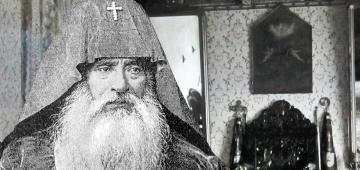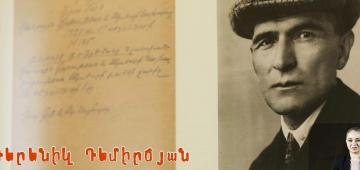 |
Spyridon MelikyanComposer Spyridon Melikyan left behind symphonic and choral works. As a conductor, he raised Armenian choral art to a new level. As an ethnographer, he saved a great treasury of folk songs from oblivion. As a scholar, he examined the theoretical issues of Armenian music in a new light. The former seminarian’s entire life was a service to Armenian music and Armenology. |
 |
Hakob AnandyanHakob Manandyan was one of the great scientists who, by teaching at the Gevorgyan Theological Seminary, had turned that institution into the world's largest center of Armenology. Manandyan spoke more than ten languages, and taught history as well as various languages at the seminary. He wrote more than 150 scientific works in Armenian, Russian, and German. After the seminary was closed, when the first state university was opened, Manandyan became the head of the history department, and then was elected rector of the university. He was one of the founding academicians of the National Academy of Sciences. When the scientist was reminded of his great merit, he replied that all this should be considered a tribute of gratitude to the seminary, where he spent his best years. |
 |
Grigor GhapantsyanJust three years after the closure of the Gevorgyan Seminary, the first state university of Armenia was opened. The vast majority of the teaching staff were former teachers of the seminary, and one of them was the linguist and Armenologist Grigor Ghapantsyan. In 1913, having rejected Nikoghayos Mar's offer to stay at the University of Saint Petersburg and work together, he returned to his homeland and entered the teaching staff of the Gevorgyan Theological Seminary. He immediately joined the group of Stepanos Malkhasyants, who was appointed Dean of the seminary, who was called upon to reform the educational programs of the seminary and write a new charter. He conducted his first serious studies at the seminary and published them in the journal "Ararat" of the Mother See. In 1918, with weapons in hand, he fought with Armenian clergy and scientists in the Battle of Sardarapat. He was the head of the Department of Linguistics of the newly opened State University, and the director of the Institute of Language of the newly established NAS. Some of the works written in Russian by the linguist who left behind a great scientific legacy have not been translated into Armenian to this day. |
 |
Stepan MalkhasyantsThe prominent Armenologist, academician Stepan Malkhasyants is one of those students of the seminary who, after improving their education in European universities, returned to their native educational institution to teach and pass on the accumulated knowledge to the next generations. Moreover, Malkhasyants also headed the seminary, and during that period implemented radical reforms. He was elected a member of the Spiritual Council of Holy Etchmiadzin. Throughout his life, even during the years of atheism and Stalinist repressions, he maintained a strong connection with the Mother See. |
 |
Makar of TeghutMakar I Catholicos of Teghut neither studied nor taught at the Gevorgyan Theological Seminary, but the seminary reached its most flourishing period during his reign. Makar was the first to update the educational programs, invite new teachers, and lay the foundation for the tradition of sending spiritual and secular graduates to prominent European universities to continue their education. |
 |
Gevork VI Chorekchyan
Archbishop Gevorg Chorekchyan was elected Catholicos of All Armenians during the most difficult times for the Armenian Church. He was able to implement huge reforms. Patriarch Gevorg VI Chorekchyan was also able to smooth over strained relations with the Bolshevik authorities and avoid new persecutions from Moscow.
|
 |
Derenik DemirchyanDerenik Demirchyan is one of the great Armenian writers who made his first literary attempts during his years of studying at the Gevorgyan Theological Seminary. Demirchyan is also one of the four alumni of the Vernata seminary founded by Hovhannes Tumanyan. His contribution to Armenian literature was great, the most significant of which is perhaps the historical novel "Vardanank", as well as the comedy "Kaj Nazar" and the drama "Yerkir Hayreni". |
 |
Catholicos Garegin Hovsepyan
Archbishop Garegin Hovsepyan was not only a student of the Gevorgyan Theological Seminary, but also led it during a difficult period. The great Armenologist and respected clergyman was one of the first students of the seminary to be ordained a celibate priest. He spent most of his life in the Mother See of Holy Etchmiadzin, was ordained a bishop, and received the rank of archbishop. He was elected Catholicos of Cilicia at the suggestion of his friend, Archbishop Gevork Chorekchian.
|
 |
Manuk AbeghyanManuk Abeghyan is one of the few great scholars who not only studied at the Gevorgyan Theological Seminary, but also taught and directed it. The great Armenologist either wrote or conceived most of his monumental works during the seminary period. Abeghyan did not break off contacts with the Mother See until the end of his life. Moreover, he was also a member of the spiritual council. |
 |
Hrachya AcharyanHrachya Acharyan taught at the Gevorgyan Theological Seminary for a short time, but that was enough to leave a big mark on the future activities of the theological seminary. The greatest Armenian linguist created a methodology for teaching several languages. He was persecuted during the Stalinist repressions. The scientist, who lost his sight in one eye since childhood, created fundamental monumental works, performing the work of an entire scientific institute activities. |
 |
The spiritual leader of the heroic battle of Sardarapat
His Holiness Patriarch Gevorg the 5th Surenyan was not only a student of the Gevorgian Theological Seminary, but also taught there, and for a time even headed that educational institution. The spiritual leader, who opened schools everywhere, was forced to announce the closure of the seminary with a heavy heart. Gevorg V became the patriarch of the Armenian Apostolic Holy Church during the most difficult period. He was the one who inspired the Armenian people during the heroic battle of Sardarapat and led them to victory.
|
 |
Armenak ShahmuradyanArmenak Shahmuradyan is the most prominent singer of all time. His education at the Gevorgyan Theological Seminary and his meeting with the great Komitas were of decisive importance for him. From then on, their activities were carried out together. Leaving the soloist's work as a soloist at the Paris Grand Opera, he devoted himself entirely to the spread of Armenian national songs, especially Komitas's arrangements, having concert tours almost all over the world. |
